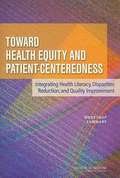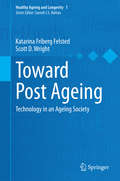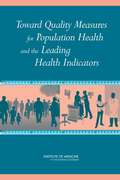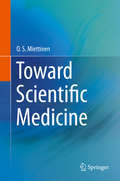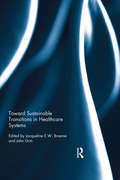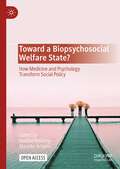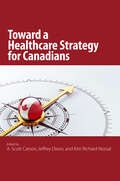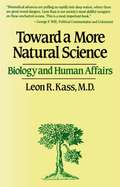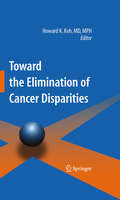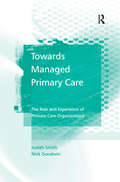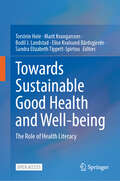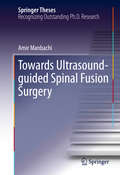- Table View
- List View
Toward Health Equity and Patient-centeredness: Integrating Health Literacy, Disparities Reduction, and Quality Improvement
by Institute of MedicineTo receive the greatest value for health care, it is important to focus on issues of quality and disparity, and the ability of individuals to make appropriate decisions based on basic health knowledge and services. The Forum on the Science of Health Care Quality Improvement and Implementation, the Roundtable on Health Disparities, and the Roundtable on Health Literacy jointly convened the workshop "Toward Health Equity and Patient-Centeredness: Integrating Health Literacy, Disparities Reduction, and Quality Improvement" to address these concerns. During this workshop, speakers and participants explored how equity in care delivered and a focus on patients could be improved.
Toward Post Ageing
by Scott D. Wright Katarina Friberg FelstedThis book examines the emergent and expanding role of technologies that hold both promise and possible peril for transforming the ageing process in this century. It discusses the points and counterpoints of technological advances that would influence a reconstruction of what it means to age when embedded in a post-human vision for a post-biological future. The book presents a provocative interdisciplinary meta-analysis that contrasts paradigms with inflection points, making the case that society has entered a new inflection point, provisionally labeled as Post Ageing. It goes on to discuss the moderate and radical versions of this inflection point and the philosophical issues that need to be addressed with the advent of post ageing activities: postponing and possibly ending ageing, primarily through technological advances. This book will be a valuable resource for professionals who wish to review the continuum of varied constructs and intersects of technologies ranging from those purporting to enhance the activities of daily living in older adults, to those that would enable the older worker to stay competitive in the labor market, to those that propose to extend longevity and ultimately, claim to transcend ageing itself--moving toward a transhumanistic domain and more specifically, a post-ageing inflection point.
Toward Quality Measures for Population Health and the Leading Health Indicators
by Institute of Medicine Board on Population Health and Public Health Practice Committee on Quality Measures for the Healthy People Leading Health IndicatorsThe Institute of Medicine (IOM) Committee on Quality Measures for the Healthy People Leading Health Indicators was charged by the Office of the Assistant Secretary for Health to identify measures of quality for the 12 Leading Health Indicator (LHI) topics and 26 Leading Health Indicators in Healthy People 2020 (HP2020), the current version of the Department of Health and Human Services (HHS) 10-year agenda for improving the nation's health. The scope of work for this project is to use the nine aims for improvement of quality in public health (population-centered, equitable, proactive, health promoting, risk reducing, vigilant, transparent, effective, and efficient) as a framework to identify quality measures for the Healthy People Leading Health Indicators (LHIs). The committee reviewed existing literature on the 12 LHI topics and the 26 Leading Health Indicators. Quality measures for the LHIs that are aligned with the nine aims for improvement of quality in public health will be identified. When appropriate, alignments with the six Priority Areas for Improvement of Quality in Public Health will be noted in the Committee's report. Toward Quality Measures for Population Health and the Leading Health Indicators also address data reporting and analytical capacities that must be available to capture the measures and for demonstrating the value of the measures to improving population health. Toward Quality Measures for Population Health and the Leading Health Indicators provides recommendations for how the measures can be used across sectors of the public health and health care systems. The six priority areas (also known as drivers) are population health metrics and information technology; evidence-based practices, research, and evaluation; systems thinking; sustainability and stewardship; policy; and workforce and education.
Toward Scientific Medicine
by O. S. MiettinenScientific medicine in Miettinen's conception of it is very different from the two ideas about it that come to eminence in the 20th century. To him, medicine is scientific to the extent that it has a rational theoretical framework and a knowledge-base from medical science. He delineates the nature of that theoretical framework and of the research to develop the requisite knowledge for application in such a framework. The knowledge ultimately needed is about diagnostic, etiognostic, and prognostic probabilities, and it necessarily is to be codified in the form of probability functions, embedded in practice-guiding expert systems. In these terms, today's medicine still is mostly pre-scientific, and major innovations are needed within and around medicine for healthcare to get to be in tune with reasonable expectations about it in this Information Age. Thus, while the leading cause of litigation for medical malpractice in the U. S. is failure to expeditiously and correctly diagnose the probability of myocardial infarction in a hospital's emergency room, this book shows that a typical modern textbook of cardiology, just as one of medicine at large, imparts no knowledge about the diagnostic probabilities needed in this, and that the prevailing type of diagnostic research will not produce the requisite knowledge. If the diagnostic pursuits in an ER would be guided by an emergency-room diagnostic expert system, this would guarantee expert diagnoses by all ER doctors. Academic leaders of medicine and medical researchers concerned to advance the knowledge-base of medicine will find a wealth of stimulus for thinking about the deficiencies of the prevailing knowledge culture in and surrounding medicine, and about the directions of the needed progress toward genuinely scientific medicine.
Toward Sustainable Transitions in Healthcare Systems (Routledge Studies in Sustainability Transitions)
by Jacqueline E.W. Broerse and John GrinHealth systems have long been considered key determinants of well-being within modern societies, a valuable resource which have faced a series of reform initiatives throughout the past decades. These reforms have been used to manage the cost of development, measure the tenability of health systems in globalizing economies and promote the increasing importance of health problems related to lifestyle and living conditions, yet they have failed to provide a true resolution to the persistent economical and logistical problems facing modern-day health systems. This rich, interdisciplinary work explores the hypothesis that many of these problems cannot be adequately addressed without structural changes to our health systems, and examines the embedded features of our health systems that underlie contemporary challenges as well as how, and under what conditions, our health systems can be made more sustainable. Combining and building upon theoretical approaches from transition and innovation studies for analysing health system deficits, Toward Sustainable Transitions in Healthcare Systems raises fundamental questions about how new research, new needs and exogenous trends are transforming current health innovation systems. Providing an original and substantial analysis of the complex structural features of the health innovation system, this book will be of interest to students and practitioners of the politics of health, social epidemiology, medical sociology and those with an interest in transition theory.
Toward a Biopsychosocial Welfare State?: How Medicine and Psychology Transform Social Policy
by Mareike Ariaans Nadine ReiblingThis open access book analyses the idea that medicine and psychology have a substantial (and underestimated) impact on Western welfare states. Based on mixed-methods analyses conducted in Germany, it analyses this influence on debates and policies related to unemployment, poverty, and childhood. The book demonstrates how the turn to neoliberalism and social investment thinking has created this medicalisation and psychologisation of social policies, and the contributions provide important insights for students and scholars of sociology of health and illness, political sociology, social and health policy, medicine, psychology, and public health.
Toward a Culture of Consequences
by Brian M. Stecher Frank Camm Cheryl L. Damberg Laura S. Hamilton Kathleen J. MullenPerformance-based accountability systems (PBASs) link incentives to measured performance to improve services to the public. Research suggests that PBASs influence provider behaviors, but little is known about PBAS effectiveness at achieving performance goals. This study examines nine PBASs that are drawn from five sectors: child care, education, health care, public health emergency preparedness, and transportation.
Toward a Health Statistics System for the 21st Century: SUMMARY OF A WORKSHOP
by Committee on National StatisticsA summary Toward a Health Statistics System for the 21st Century
Toward a Healthcare Strategy for Canadians
by A. Scott Carson Jeffrey Dixon Kim Richard NossalWhile Canadians are proud of their healthcare system, the reality is that it is fragmented and disorganized. Instead of a pan-Canadian system, it is a "system of systems" - thirteen provincial and territorial systems and a federal system. As a result, Canadian healthcare has not only become one of the costliest in the world, but is falling well behind many developed countries in terms of quality. Canadians increasingly realize that their healthcare system is no longer fiscally sustainable, yet change remains elusive. The standard claim is that Canada's multijurisdictional approach makes system-wide reform nearly impossible. Toward a Healthcare Strategy for Canadians disputes this reasoning, making the case for a comprehensive, system-wide, made-in-Canada healthcare strategy. It looks at the mechanics of change and suggests ways in which the various participants in the system - governments, healthcare professionals, the private sector, and patients - can work collaboratively to transform a second-rate system. Addressing critical issues of health human resources, electronic health records, integrated care, and pharmacare, Toward a Healthcare Strategy for Canadians shows how a system-wide strategic approach to this crucial policy area can make a difference in Canada's healthcare system in the future.
Toward a Healthcare Strategy for Canadians (Queen's Policy Studies Series)
by A. Scott Carson Jeffrey Dixon Kim Richard NossalWhile Canadians are proud of their healthcare system, the reality is that it is fragmented and disorganized. Instead of a pan-Canadian system, it is a "system of systems" - thirteen provincial and territorial systems and a federal system. As a result, Canadian healthcare has not only become one of the costliest in the world, but is falling well behind many developed countries in terms of quality. Canadians increasingly realize that their healthcare system is no longer fiscally sustainable, yet change remains elusive. The standard claim is that Canada's multijurisdictional approach makes system-wide reform nearly impossible. Toward a Healthcare Strategy for Canadians disputes this reasoning, making the case for a comprehensive, system-wide, made-in-Canada healthcare strategy. It looks at the mechanics of change and suggests ways in which the various participants in the system - governments, healthcare professionals, the private sector, and patients - can work collaboratively to transform a second-rate system. Addressing critical issues of health human resources, electronic health records, integrated care, and pharmacare, Toward a Healthcare Strategy for Canadians shows how a system-wide strategic approach to this crucial policy area can make a difference in Canada’s healthcare system in the future.
Toward a Healthier Garden State: Beyond Cancer Clusters and COVID
by Michael R. Greenberg Dona SchneiderWhile New Jersey now frequently appears near the top in listings of America’s healthiest states, this has not always been the case. The fluctuations in the state’s overall levels of health have less to do with the lifestyle choices of individual residents and more to do with broader structural issues, ranging from pollution to urban design to the consolidation of the health care industry. This book uses the past fifty years of New Jersey history as a case study to illustrate just how much public policy decisions and other upstream factors can affect the health of a state’s citizens. It reveals how economic and racial disparities in health care were exacerbated by bad policies regarding everything from zoning to education to environmental regulation. The study further chronicles how New Jersey struggled to deal with public health crises like the AIDS epidemic and the crack epidemic. Yet it also explores how the state has developed some of the nation’s most innovative responses to public health challenges, and then provides policy suggestions for how we might build an even healthier New Jersey.
Toward a More Natural Science: Biology and Human Affairs
by Leon R. KassKass shows how the promise and the peril of our time are inextricably linked with the promise and the peril of modern science.<P><P> The relation between the pursuit of knowledge and the conduct of life — between science and ethics, each broadly conceived — has in recent years been greatly complicated by developments in the science of life. This book examines the ethical questions involved in prenatal screening, in vitro fertilization, artificial life forms, and medical care, and discusses the role of human beings in nature.
Toward the Elimination of Cancer Disparities
by Howard K. KohThe societal burden of cancer is one of the major public health challenges of our time, yet that burden is not equally shared by all. Troubling disparities have been documented not only by racial/ethnic group but also by social class, insurance status, geography, and a host of other factors. Furthermore, such disparities represent the end result of a constellation of forces stemming from both within the health care system and outside of it. Many currently existing cancer disparities are preventable. To date, few publications capture the breadth and depth of the dimensions of cancer disparities from both the clinical and public health perspective. In this volume, we will broaden concepts of disparities beyond traditional race/ethnicity discussions to explore a more systematic analysis of how, where, and why disparities occur across the cancer continuum.We will also analyze the issue of social disparities with respect to certain major cancers, with emphasis on the particular role of socioeconomic position. This volume reflects the work of a number of experts in cancer disparities, led by members of the Executive Committee of the Program-in-Development for the Dana Farber / Harvard Cancer Center. In particular, this volume updates and expands an earlier 2005 monograph on the topic published in the journal Cancer Causes and Control (Nancy Krieger PhD, Editor).
Toward the Health of a Nation: The Institute of Health Policy, Management and Evaluation - The First Seventy Years
by Leslie A. BoehmCanadians view their healthcare – recognized throughout the world as an exemplary system – as iconic and integral to their identity. In Toward the Health of a Nation Leslie Boehm recounts the first seventy years in the life of one of the foundations of Canada's healthcare system, the Institute of Health Policy, Management and Evaluation at the University of Toronto. Boehm – a graduate of IHPME, and an instructor there throughout his career – charts the institute's history from its inception in 1947 as the Department of Hospital Administration to the present day. The first program of its kind in Canada, and one of the few in the world, the school was founded at a time when the issue of healthcare was becoming a significant part of national and provincial discussions and policies. Initially concentrating on hospital management and professional degrees, it has expanded to offer academic degrees and facilitate important research into health systems, policies, and outcomes. In Toward the Health of a Nation Boehm demonstrates the excellence of the program, its faculty, and its graduates, as well as their accomplishments in major government initiatives and royal commissions. In the seventy years since IHPME's inception healthcare has grown to become a major part of government and business activity, and it will only increase in coming years. An in-depth history of a major program in graduate health education, Toward the Health of a Nation highlights how important healthcare is to a modern, functional society.
Toward the Healthy City: People, Places, and the Politics of Urban Planning (Urban and Industrial Environments)
by Jason CorburnA call to reconnect the fields of urban planning and public health that offers a new decision-making framework for healthy city planning.In distressed urban neighborhoods where residential segregation concentrates poverty, liquor stores outnumber supermarkets, toxic sites are next to playgrounds, and more money is spent on prisons than schools, residents also suffer disproportionately from disease and premature death. Recognizing that city environments and the planning processes that shape them are powerful determinants of population health, urban planners today are beginning to take on the added challenge of revitalizing neglected urban neighborhoods in ways that improve health and promote greater equity. In Toward the Healthy City, Jason Corburn argues that city planning must return to its roots in public health and social justice. The first book to provide a detailed account of how city planning and public health practices can reconnect to address health disparities, Toward the Healthy City offers a new decision-making framework called “healthy city planning” that reframes traditional planning and development issues and offers a new scientific evidence base for participatory action, coalition building, and ongoing monitoring. To show healthy city planning in action, Corburn examines collaborations between government agencies and community coalitions in the San Francisco Bay area, including efforts to link environmental justice, residents' chronic illnesses, housing and real estate development projects, and planning processes with public health. Initiatives like these, Corburn points out, go well beyond recent attempts by urban planners to promote public health by changing the design of cities to encourage physical activity. Corburn argues for a broader conception of healthy urban governance that addresses the root causes of health inequities.
Toward the Sunrising (Cheney Duvall, M. D. #4)
by Gilbert Morris Lynn MorrisConflict, Treachery, and Sinister Danger in the Streets of a Beleaguered Southern City TOWARD THE SUNRISING With New Orleans as their destination, Cheney Duvall and her nurse, Shiloh Irons, leave behind the glittering lights of New York City and travel first to Charleston, South Carolina, intending to stay for only a short time. But the purpose of their stop immediately draws them into the plight of this war-torn Southern city, in the painful throes of Reconstruction and carpetbagger policies after the Civil War. Cheney finds herself in conflict with the most respected doctor in Charleston, who is also the hospital administrator. She discovers that his old-school medical practices are not only questionable but are positively horrific. He refuses to acknowledge Cheney as a lady, much less an accredited physician. Meanwhile, Shiloh finds strong evidence that one of the most powerful businessmen in Charleston is cheating Southern merchants and is likely stealing from Cheney's father, Richard Duvall. As Cheney and Shiloh are embroiled in the political, social, and economic troubles that plague the city, they also are drawn into events related to the beginnings of the Knights of the White Rose, a fraternal order of white supremacists. Cheney and Rissy, her companion, find that they may not only be involved in social conflicts--their very lives are in danger!
Towards Community Mental Health
by John D SutherlandTavistock Press was established as a co-operative venture between the Tavistock Institute and Routledge & Kegan Paul (RKP) in the 1950s to produce a series of major contributions across the social sciences. This volume is part of a 2001 reissue of a selection of those important works which have since gone out of print, or are difficult to locate. Published by Routledge, 112 volumes in total are being brought together under the name The International Behavioural and Social Sciences Library: Classics from the Tavistock Press. Reproduced here in facsimile, this volume was originally published in 1971 and is available individually. The collection is also available in a number of themed mini-sets of between 5 and 13 volumes, or as a complete collection.
Towards Healthy Settlements: Health Implications of Residential Suburbanization in Guangzhou (Urban Sustainability)
by Tianyao ZhangThis book aims to formulate recommendations for achieving a healthy neighborhood living environment for the middle-income people in China‘s suburbs. In China, the expeditious urbanization triggers the prosperous commodity housing development, which further grows with the spatial restructuring and socioeconomic transition. Residential suburbanization is generated, accompanied with the emergence of new-middle class and the change of lifestyle. However, the health effects of suburbanization in China are overlooked. This book investigates the health performance of suburban residents and the effects of suburban living on residents‘ health. This book also examines the resident-environment transaction modes to unfold the underlying mechanism of suburban living affecting residents’ health. Suburban residents had to passively adapt to their residential environment, which is the obstacle for achieving a health-promoting environment. The institutional dynamics determining the health performance of suburban living environment were addressed with the roles of governments, developers, planners, housing managers, residents‘ committee, and ordinary residents in commodity housing development. The book found no institutional support for the creation of health-promoting environments, especially with default of governments and excessive dependence on developers for public service facilities and the absence of civil society. Thus, the book proposes that institutional innovations are necessary in term of embedding the health dimension in all sectors of the society, enlisting collaboration between public and private sectors, and between health and non-health sectors, and thus cultivating the optimization of residents-environment transactions to create health-promoting environments.
Towards Healthy and Sustainable Diets: Perspectives And Policy To Promote The Health Of People And The Planet (Springerbriefs In Public Health)
by Sirpa SarlioThis clear-sighted volume synthesizes wide-ranging knowledge of human food consumption, food production systems, and sustainability to offer methods of improving the impact of food choices on people and the environment. The comprehensive coverage addresses myriad challenges and paradoxes (e.g., health-conscious food choices that put greater stress on the planet, hunger amidst plenty) associated with the production of sustainable, nutritious food. Direct and complex links between local and global issues are highlighted in innovative approaches to transforming food production from the farm to the table and from the policy desk to the real world. Chapters identify, examine, and offer realistic recommendations for achieving critical goals, among them: Supporting healthy people and communities within planetary boundaries Reduction and prevention of food waste Combining health and sustainability on the plate "Serving sustainable and healthy food to consumers and decision makers": from commitment to action. Investing in healthier and more sustainable production. Ensuring a healthy sustainable diet is a goal of all public policies. Towards Healthy and Sustainable Diets is geared toward professionals and policymakers dealing with food, nutrition, and environmental topics seeking new perspectives on longstanding issues in these interrelated areas. It also makes a suitable reference for students studying and conducting research in these areas.
Towards Managed Primary Care: The Role and Experience of Primary Care Organizations
by Judith Smith Nick GoodwinThe last decade has witnessed a transformation in the organization and management of primary care. In Towards Managed Primary Care, the authors examine the background and development of Primary Care Groups and Primary Care Trusts (PCG/Ts) in the English NHS. The book focuses on the practical experience of developing and managing PCG/Ts and on the lessons that can be drawn from this for future policy relating to the management and evaluation of such organizations in the UK and elsewhere. The work: ¢ Provides an overview of the background to the development of PCG/Ts in England, set within the context of international developments of similar primary care organizations; ¢ Examines the organization and management of PCG/Ts; ¢ Analyses the impact of PCG/Ts on the provision of health services and on the wider health system; ¢ Explores the challenges inherent in carrying out research into primary care organizations; ¢ Focuses on the future development and evaluation of primary care organizations. With chapter conclusions setting out evidence-based lessons for developing and researching primary care organizations, this book will be an invaluable guide for all those interested or involved in health policy, health services research and primary care organization and management.
Towards Newborn Survival: Challenges and Priorities
by Sandhya R. MahapatroThis book offers a comprehensive study of the complexities of newborn survival in resource-poor regions, using the state of Bihar (India) as a case study. It provides important lessons for other low-performing countries, in similar socioeconomic contexts, where newborn survival is a major challenge.The volume opens with a brief account of the trends and regional variations in neonatal mortality. The empirical verification of socio-cultural, economic and health system barriers and the state interventions that affect newborn survival are subsequently explored. Innovative strategies are then proposed to scale up maternal newborn and child health (MNCH) services and improve neonatal health outcomes. Addressing this issue through appropriate policy action is essential to achieving Sustainable Development Goal-3, "Good Health and Well-being". This book will therefore appeal to public health scholars, professionals and policymakers interested in improving outcomes in low-income regions.
Towards Optimal Management of Diabetes in Surgery
by Sanjeev Kelkar Shubhangi Muley Prakash AmbardekarThis book addresses key principles in the optimal management of diabetes to facilitate smooth and safe anesthesia and surgery with the best possible outcomes. It addresses a range of topics, including: diabetic emergencies, glycemic control in emergencies, the routine perioperative setting, preoperative evaluation in routine and emergency surgery, intra- and post-operative management for neurosurgery, cardiothoracic surgery, gestational diabetes, bariatric surgery and other major surgeries. A dedicated chapter on Metabolic Havoc of Uncontrolled Diabetes provides the in-depth understanding of diabetic pathophysiology required in surgical situations, while a special chapter addresses commonly asked questions on surgery and diabetes. Despite many recent advances in surgery, anesthesia, and diabetes research, perioperative diabetes management is often not addressed adequately. This is largely due to an insufficient understanding of insulin physiology and its pharmacokinetics and pharmacodynamics under normal and stressful conditions. The optimal management of surgery in diabetes calls for an integrated, collaborative, and proactive approach. Surgeons, anesthetists and physicians should know the central, basic aspects of perioperative diabetes management and understand the contribution that each one makes to the best outcome, as well as their limitations.
Towards Practical Brain-Computer Interfaces
by Anton Nijholt Brendan Z. Allison Robert Leeb Stephen Dunne José Del R. MillánBrain-computer interfaces (BCIs) are devices that enable people to communicate via thought alone. Brain signals can be directly translated into messages or commands. Until recently, these devices were used primarily to help people who could not move. However, BCIs are now becoming practical tools for a wide variety of people, in many different situations. What will BCIs in the future be like? Who will use them, and why? This book, written by many of the top BCI researchers and developers, reviews the latest progress in the different components of BCIs. Chapters also discuss practical issues in an emerging BCI enabled community. The book is intended both for professionals and for interested laypeople who are not experts in BCI research.
Towards Sustainable Good Health and Well-being: The Role of Health Literacy
by Torstein Hole Marit Kvangarsnes Bodil J. Landstad Elise Kvalsund Bårdsgjerde Sandra Elizabeth Tippett-SpirtouThe purpose of this open access book is threefold. The first is to shed light on patient participation and health literacy for Good Health and Well-being, which is one of the UN's Sustainable Development Goals. Health literacy is considered a prerequisite for patients to be able to participate in shared decisions on their own treatment (WHO,1998). Health literacy has received increased international attention: the concept is linked to person-centred health services, sustainable resource utilization, health-promoting and preventive health work, treatment of chronic diseases and social inequality (WHO, 2016). The second purpose is to provide health professionals and students with educational models for building health literacy for patients and relatives. This purpose is linked to Quality Education, one of the UN's sustainability goals. The third purpose is to present critical perspectives on the demand for sustainability in healthcare services. Both ethical dilemmas and philosophical reflections on patient participation, health literacy and sustainability are presented. The Norwegian definition of health literacy is as follows: “Health competence is a person's ability to understand, assess and apply health information to be able to take knowledge-based decisions related to one's own health. This applies to both decisions related to lifestyle choices, disease prevention measures, self-management of disease and use of the health and care service” (Helsedireektoratet, 2020). The sustainability goal is clearly outlined in this definition, although the organisational perspective on health literacy is lacking. Patient participation leads to improved patient satisfaction and safety (Castro, Van Regenmortel, Vanhaecht, Sermeus, & Van Hecke, 2016; Collins, Britten, Ruusuvuori, & Thompson, 2007; Vahdat, Hamzehgardeshi, Hessam, & Hamzehgardeshi, 2014), efficient co-operation between patients and healthcare professionals, and enhanced management ofthe disease (Collins et al., 2007; Vahdat et al., 2014). Health literacy as well as patient participation are important aspects for sustainable development and good and effective healthcare services in the future.
Towards Ultrasound-guided Spinal Fusion Surgery
by Amir ManbachiThis thesis describesthe design and fabrication of ultrasound probes for pedicle screw guidance. Theauthor details the fabrication of a 2MHz radial array for a pedicle screw insertioneliminatingthe need for manual rotation of the transducer. He includes radial images obtainedfrom successive groupings of array elements in various fluids. He also examines the manner in which it canaffect ultrasound propagation.
